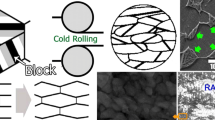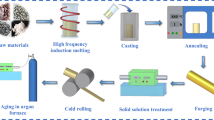Conclusions
-
1.
In alloys based on Fe−33% Cr−12% Co−2% Cu alloyed with 1% Al (alloy 2) or 1.5% Nb (alloy 3) the temperature for quenching to α-solid solution is reduced from 1050 (alloy 1) to 1000 (alloy 2) or 950°C (alloy 3). The temperature for the start of α-solid solution decomposition for the alloys is 935–640°C.
-
2.
Additional alloying with 1% Al and 1.5% Nb leads to a reduction in α-solid solution grain size and to creation of better conditions for intermediate plastic deformation.
-
3.
As a result of intermediate flat rolling α1-phase precipitates take on a lamellar shape. In this way shape anisotropy is observed for α1-phase precipitates.
-
4.
The optimum structure of strain aged alloys is obtained with vp.a=50° K/h., ε=67%, and final aging with controlled cooling from 600 to 550°C at a rate of 15° K/h. and from 550 to 500°C at a rate of 8°K/h [1].
Similar content being viewed by others
Literature cited
S. Jin, "Deformation induced anisotropic Cr-Co-Fe permanent magnet alloys" IEEE Trans. Mgn.,15, 1748–1750 (1979).
H. Kaneko, M. Homma, M. Okada, et al., "Fe-Cr-Co ductile magnet with (BH)max=8M.G.Oe", Magn. Magn. Mater., AIP Conf. Proc., Philadelphia No. 29, 620–621 (1975).
N. N. Konev and B. A. Samarin, "Effect of wire drawing on the structure and magnetic properties of strain-aged alloys based on Fe-Cr-Co-Cu", Izv. Vyssh. Uchebn. Zaved., Chern. Metall., No. 5, 86–88 (1983).
N. N. Konev, B. A. Samarin, and I. A. Mekhem, "Structure and magnetic properties of alloys based on Fe-Cr-Co-Cu subjected to strain aging with rolling in grooved rolls", Izv. Vyssh. Uchebn. Zaved., Chern. Metall., No. 11, 78–79 (1982).
M. Homma, "Permanent magnets in the Fe-Cr-Co system", First Internat. Seminar on Magnetism (1977).
Additional information
Moscow Institute of Steels and Alloys (MISiS). Translated from Metallovedenie i Termicheskaya Obrabotka Metallov, No. 9, pp. 54–56, September, 1986.
Rights and permissions
About this article
Cite this article
Samarin, B.A., Kolchin, A.E. & Kal'ner, Y.V. Effect of prior aging and flat rooling on the structure and magnetic properties of alloys of the Fe-Cr-Co-Cu system. Met Sci Heat Treat 28, 690–693 (1986). https://doi.org/10.1007/BF00742754
Issue Date:
DOI: https://doi.org/10.1007/BF00742754




